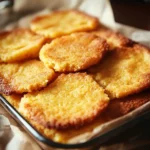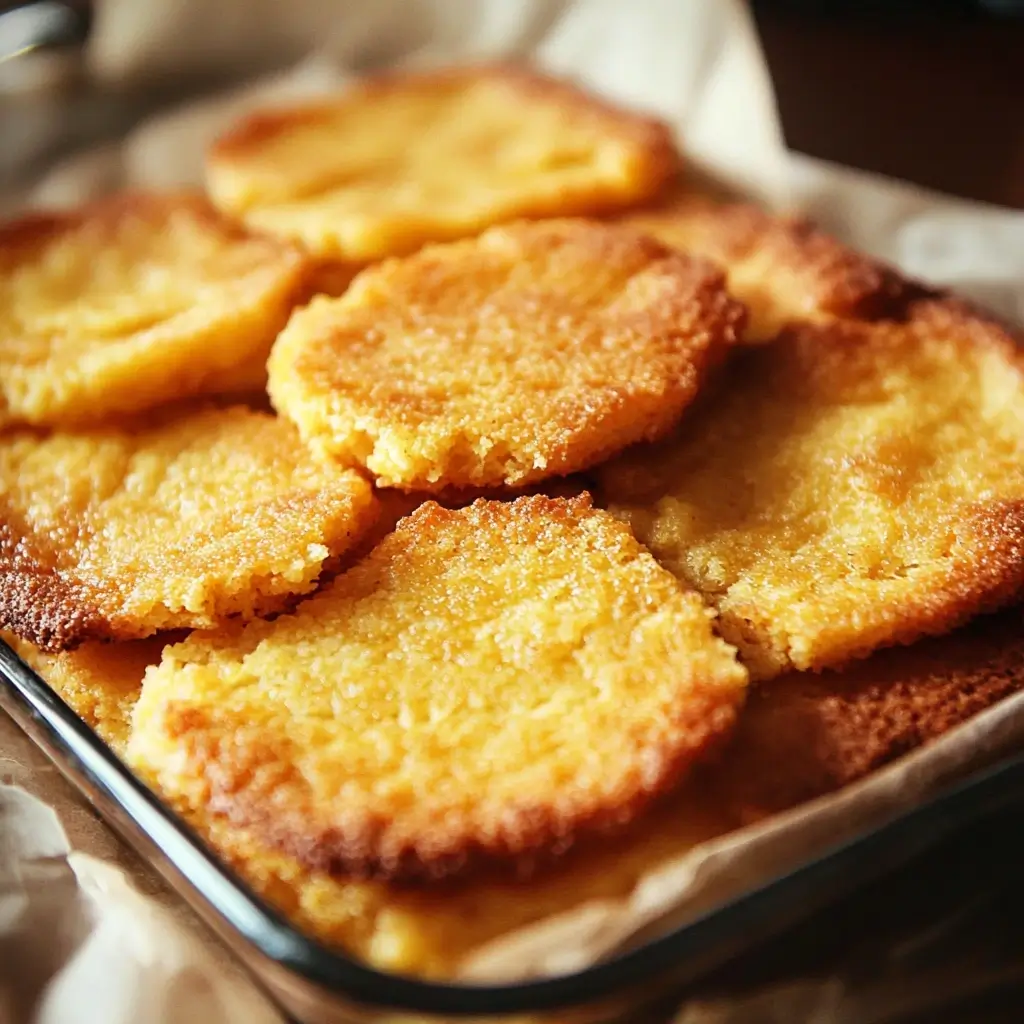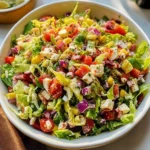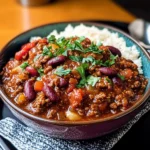It’s funny how some of the simplest recipes can become the most cherished. Hot water cornbread, a humble dish with roots deep in Southern tradition, is a perfect example. For years, I’d heard whispers of this unique cornbread, intrigued by the idea of using hot water to create a different texture and flavor. Finally, on a whim during a family barbecue, I decided to give it a try. The results? Let’s just say it vanished faster than the ribs! My kids, usually picky about anything that isn’t pizza or chicken nuggets, were clamoring for more of these crispy, slightly chewy, golden-brown discs. Even my notoriously critical father-in-law, a Southern gentleman with high cornbread standards, declared it “right good.” Since then, hot water cornbread has become a regular feature at our table, a testament to its simple deliciousness and comforting charm. It’s a recipe that proves you don’t need fancy ingredients or complicated techniques to create something truly special. This isn’t just cornbread; it’s a taste of history, a bite of warmth, and a guaranteed crowd-pleaser. Let’s dive into how you can bring this Southern staple to your own kitchen.
Ingredients for Authentic Hot Water Cornbread
Crafting the perfect hot water cornbread begins with understanding the importance of each ingredient. While the list is remarkably short, the quality and proportions play a crucial role in achieving that signature texture and flavor. This isn’t about fancy pantry staples; it’s about simple, honest ingredients working in harmony. Let’s break down what you’ll need for this Southern classic:
- 1 cup Yellow Cornmeal: The heart and soul of hot water cornbread. It’s important to use yellow cornmeal, as it provides a slightly sweeter and more robust flavor compared to white cornmeal. Look for a medium-grind cornmeal for the best texture – not too coarse that it’s gritty, and not too fine that it becomes mushy. Stone-ground cornmeal, if available, will lend an even richer, more authentic taste and slightly coarser texture, which many prefer in traditional cornbread. The type of cornmeal will directly impact the final texture and flavor profile of your cornbread, so choosing quality cornmeal is a key step.
- 1 teaspoon Salt: Salt is not just about flavor enhancement; it’s crucial for balancing the sweetness of the cornmeal and developing the gluten (though cornmeal is gluten-free, it still benefits from salt in terms of texture). Use regular table salt or fine sea salt. Avoid coarse sea salt or kosher salt unless you finely grind it beforehand, as larger salt crystals might not dissolve properly in the hot water and could result in uneven seasoning. The right amount of salt will elevate the other flavors and prevent the cornbread from tasting bland.
- ¾ cup Boiling Water: This is the magic ingredient that sets hot water cornbread apart. The boiling water partially cooks the cornmeal, creating a unique, slightly gelatinous texture that contributes to the cornbread’s signature chewiness and prevents it from being crumbly. Make sure the water is truly boiling for the best results. Using water that is not hot enough will not achieve the desired effect on the cornmeal and can lead to a denser, less tender cornbread. Measuring the water accurately is also important to maintain the correct batter consistency.
- 2 tablespoons Vegetable Oil or Lard (for frying): The choice of frying fat contributes to the final flavor and crispiness. Vegetable oil is a neutral option that allows the cornmeal flavor to shine through. Lard, on the other hand, is a traditional Southern choice that imparts a rich, savory flavor and helps create an extra crispy exterior. Other oils like peanut oil or canola oil can also be used. Avoid olive oil, as its flavor can be too strong and might not be the most traditional choice for frying cornbread. Ensure you have enough oil in your skillet to shallow fry the cornbread patties properly, allowing them to become golden brown and crispy on both sides.
Optional Ingredients for Flavor Variations:
While classic hot water cornbread is delicious in its simplicity, you can certainly experiment with a few additions to customize the flavor profile. These additions should be used sparingly to complement, not overpower, the fundamental taste of the cornbread.
- Pinch of Sugar (optional): Some recipes include a very small amount of sugar, typically just a teaspoon or less, to slightly enhance the sweetness of the cornmeal. This is entirely optional and depends on your personal preference. If you prefer a more savory cornbread, you can omit the sugar entirely. If you do add sugar, use granulated sugar or even a touch of brown sugar for a slightly deeper flavor note.
- Pinch of Black Pepper (optional): A very small pinch of freshly ground black pepper can add a subtle warmth and depth of flavor to the cornbread, balancing the sweetness of the corn and the saltiness. Use freshly ground black pepper for the best aroma and flavor. Be careful not to add too much, as pepper can easily become overpowering.
- Finely Chopped Green Onions or Chives (optional): For a touch of freshness and mild onion flavor, you can add a tablespoon or two of finely chopped green onions or chives to the batter. These should be added after the hot water and salt have been mixed with the cornmeal. They add a subtle herbaceous note and a bit of color to the cornbread.
- A Dash of Hot Sauce (optional): For those who like a little heat, a dash of your favorite hot sauce can be mixed into the batter. This adds a subtle kick without making the cornbread overly spicy. Choose a hot sauce that complements the cornmeal flavor, such as a mild pepper sauce or a vinegar-based hot sauce.
Ingredient Quality Matters:
Even with a simple recipe like hot water cornbread, the quality of your ingredients will directly impact the final result. Using fresh, high-quality cornmeal will make a noticeable difference in flavor and texture. If possible, try to source cornmeal from a reputable mill or farmer’s market. Freshly ground cornmeal will have a more vibrant flavor and a coarser texture, which is ideal for hot water cornbread. While pantry staples are perfectly acceptable, being mindful of ingredient quality can elevate this humble dish to something truly exceptional.
Step-by-Step Instructions for Perfect Hot Water Cornbread
Making hot water cornbread is surprisingly straightforward and quick, but following the steps in the correct order and paying attention to detail is key to achieving that perfect texture and flavor. Let’s walk through the process, step-by-step, ensuring you understand each stage for cornbread success.
Step 1: Prepare Your Ingredients and Equipment
Before you begin mixing, it’s always best to have everything prepped and ready to go. This ensures a smooth and efficient cooking process.
- Measure out your cornmeal and salt: Accurately measure 1 cup of yellow cornmeal and 1 teaspoon of salt into a medium-sized mixing bowl. Having these dry ingredients pre-measured saves time and prevents mistakes during the mixing process.
- Boil the water: Bring ¾ cup of water to a rolling boil. You can use a kettle or a saucepan for this. The key is to ensure the water is truly boiling, as this is crucial for partially cooking the cornmeal and creating the desired texture. Using a measuring cup specifically for hot liquids is recommended for safety and accuracy.
- Heat your skillet with oil: Place a cast iron skillet or a heavy-bottomed skillet over medium-high heat. Add approximately 2 tablespoons of vegetable oil or lard to the skillet. Allow the oil to heat up properly until it shimmers. The oil should be hot enough to sizzle gently when a tiny drop of batter is added. Heating the skillet and oil beforehand is essential for achieving crispy cornbread and preventing sticking.
Step 2: Mix the Batter
This is where the magic happens! The hot water is what transforms the simple cornmeal into a unique batter.
- Combine dry ingredients: In your mixing bowl with the cornmeal and salt, whisk the dry ingredients together briefly to ensure the salt is evenly distributed. This step is simple but helps to prevent pockets of salt in the final cornbread.
- Pour in the boiling water: Carefully pour the boiling water into the bowl with the cornmeal and salt. Be cautious as the hot water will create steam.
- Stir vigorously: Immediately stir the mixture vigorously with a spoon or spatula until a thick, smooth batter forms. The hot water will quickly hydrate the cornmeal, and the mixture will become quite thick and almost paste-like. Continue stirring until there are no lumps of dry cornmeal remaining and the batter is uniformly smooth. The consistency should be thick enough to hold its shape when dropped from a spoon but still pliable enough to spread slightly.
- Let the batter rest briefly (optional but recommended): Allow the batter to rest for a few minutes (about 2-3 minutes) after mixing. This allows the cornmeal to fully absorb the hot water and further develop its texture. While this step is optional, it can contribute to a slightly smoother and more cohesive batter.
Step 3: Fry the Cornbread
Now it’s time to cook the cornbread and achieve that golden-brown crispiness.
- Shape the batter: Using a spoon or your hands (if the batter has cooled slightly and is manageable), scoop out portions of the batter and gently shape them into small, flat patties. Aim for patties that are about ¼ to ½ inch thick and 2-3 inches in diameter. You can make them round, oval, or any shape you prefer. The size and thickness will affect the cooking time and crispiness, so try to keep them relatively uniform for even cooking.
- Carefully place patties in hot skillet: Gently place the cornbread patties into the hot skillet with the shimmering oil. Do not overcrowd the skillet; work in batches if necessary to ensure each patty cooks evenly and gets crispy. Overcrowding can lower the oil temperature and lead to soggy cornbread.
- Fry until golden brown and crispy: Fry the cornbread patties for about 3-4 minutes per side, or until they are golden brown and crispy on the bottom. Use a spatula to carefully flip them over to cook the other side. Monitor the heat and adjust if necessary; if the cornbread is browning too quickly, reduce the heat slightly to prevent burning. The frying time may vary slightly depending on the thickness of the patties and the heat of your skillet.
- Remove and drain excess oil: Once the cornbread patties are golden brown and crispy on both sides, remove them from the skillet using a slotted spoon or spatula and place them on a plate lined with paper towels to drain any excess oil. This step helps to prevent the cornbread from becoming greasy.
Step 4: Serve and Enjoy
Hot water cornbread is best enjoyed fresh and warm.
- Serve immediately: Hot water cornbread is at its peak crispiness and flavor when served immediately after frying. Serve them while they are still warm and golden brown.
- Enjoy plain or with your favorite toppings: Hot water cornbread is delicious on its own, but it also pairs wonderfully with a variety of toppings and accompaniments. See the “How to Serve” section for serving suggestions.
Tips for Success:
- Use boiling water: Make sure the water is at a rolling boil when you add it to the cornmeal. This is crucial for the texture.
- Don’t overmix: Stir just until the batter is combined and smooth. Overmixing can make the cornbread tough.
- Hot skillet and oil: Ensure your skillet and oil are hot before adding the cornbread patties for optimal crispiness.
- Don’t overcrowd the skillet: Fry in batches if needed to maintain oil temperature and prevent soggy cornbread.
- Serve immediately: Hot water cornbread is best enjoyed fresh and warm.
By following these step-by-step instructions and tips, you’ll be well on your way to making delicious, authentic hot water cornbread that will be a hit with everyone who tries it.
Nutrition Facts for Hot Water Cornbread
Understanding the nutritional profile of your favorite dishes is always helpful, especially when considering balanced eating. Hot water cornbread, while a comforting and delicious treat, should be enjoyed in moderation as part of a varied diet. Please note that these are approximate values and can vary slightly based on specific ingredients and cooking methods.
Serving Size: 1 patty (approximately ¼ of the recipe)
Approximate Nutrition Facts Per Serving:
- Calories: 150-200 kcal
- Total Fat: 8-12g
- Saturated Fat: 1-2g
- Trans Fat: 0g
- Monounsaturated Fat: 4-6g
- Polyunsaturated Fat: 2-4g
- Cholesterol: 0mg
- Sodium: 200-300mg
- Total Carbohydrates: 18-25g
- Dietary Fiber: 2-3g
- Total Sugars: <1g
- Protein: 2-3g
Key Nutritional Considerations:
- Calories: Hot water cornbread is moderately calorie-dense, primarily due to the cornmeal and the oil used for frying. Portion control is important when enjoying this dish.
- Fat Content: The fat content comes primarily from the oil used for frying. Choosing a healthier oil like canola or peanut oil can slightly improve the fat profile compared to lard or vegetable oil. However, it’s still a fried food, so the fat content will be relatively higher than baked cornbread.
- Carbohydrates: Cornmeal is a carbohydrate source, providing both starch and some dietary fiber. The fiber content is relatively modest but contributes to digestive health.
- Sodium: The sodium content comes from the added salt. While not excessively high, individuals watching their sodium intake should be mindful of portion sizes and can consider reducing the salt slightly in the recipe if needed.
- Protein: Hot water cornbread is not a significant source of protein. It’s best enjoyed as a side dish alongside protein-rich foods.
- Vitamins and Minerals: Cornmeal provides some vitamins and minerals, including iron, magnesium, and B vitamins. However, the amounts are not substantial in a single serving.
Factors Affecting Nutritional Value:
- Type of Oil: The type of oil used for frying significantly impacts the fat profile. Lard will have a higher saturated fat content compared to vegetable or canola oil.
- Size of Patties: Larger patties will naturally contain more calories and nutrients than smaller patties.
- Optional Additions: Adding ingredients like sugar, cheese, or bacon will alter the nutritional content.
Disclaimer:
These nutrition facts are estimates and for informational purposes only. For precise nutritional information, you can use online nutrition calculators or consult with a registered dietitian, especially if you have specific dietary needs or concerns. Enjoy hot water cornbread as a treat and part of a balanced eating plan.
Preparation Time for Hot Water Cornbread
One of the many appeals of hot water cornbread is its speed and simplicity. From start to finish, you can have these crispy delights on your table in a remarkably short time. This makes it an ideal choice for a quick side dish, a last-minute addition to a meal, or even a satisfying snack when you’re short on time.
Total Preparation Time: Approximately 15-20 minutes
Let’s break down the time commitment involved:
- Prep Time (Measuring Ingredients, Boiling Water, Heating Skillet): 5-7 minutes
- This includes gathering your ingredients, measuring out the cornmeal and salt, bringing the water to a boil, and heating the skillet with oil. These are all quick and straightforward tasks.
- Mixing Time (Making the Batter): 2-3 minutes
- Mixing the batter is very fast. It involves simply pouring the boiling water into the dry ingredients and stirring until combined. The batter comes together quickly.
- Cooking Time (Frying the Cornbread): 8-10 minutes
- Frying the cornbread patties takes approximately 3-4 minutes per side, and you’ll likely cook them in batches. The cooking time may vary slightly depending on the thickness of your patties and the heat of your skillet.
Time-Saving Tips:
- Pre-measure ingredients: Have your cornmeal and salt pre-measured before you start boiling the water. This will streamline the process.
- Use an electric kettle: An electric kettle will boil water much faster than a stovetop kettle or saucepan.
- Heat the skillet while water boils: Start heating your skillet with oil while the water is coming to a boil. This way, the skillet will be hot and ready as soon as the batter is mixed.
- Work efficiently: Once you start frying, work efficiently to shape and place the patties in the skillet and flip them when they are ready.
Perfect for Busy Weeknights:
The short preparation time makes hot water cornbread an excellent choice for busy weeknights when you need a quick and satisfying side dish to complement your main course. It’s also a great option when you have unexpected guests and want to whip up something delicious without spending hours in the kitchen. Its speed and simplicity are a testament to its practicality and enduring popularity.
How to Serve Hot Water Cornbread
Hot water cornbread is incredibly versatile and can be enjoyed in countless ways, from simple and traditional to more creative and modern pairings. Its slightly savory and subtly sweet flavor profile makes it a fantastic accompaniment to a wide range of dishes and cuisines. Here are some delicious ways to serve hot water cornbread:
Classic Southern Style:
- With Butter and Honey: The simplest and perhaps most beloved way to enjoy hot water cornbread is with a generous pat of butter and a drizzle of honey. The creamy butter melts into the warm cornbread, and the honey adds a touch of sweetness that perfectly complements the cornmeal flavor.
- With Molasses: For a more traditional and slightly richer sweetness, serve hot water cornbread with molasses. The deep, earthy sweetness of molasses is a classic Southern pairing.
- Alongside Greens: Collard greens, turnip greens, or mustard greens are quintessential Southern side dishes that pair beautifully with hot water cornbread. The slightly bitter greens and savory cornbread create a balanced and satisfying meal.
- With Beans: Black-eyed peas, pinto beans, or butter beans are other Southern staples that are enhanced by hot water cornbread. The cornbread is perfect for sopping up the flavorful bean broth.
- With Fried Chicken or BBQ: Hot water cornbread is a natural partner to classic Southern comfort foods like fried chicken, barbecue ribs, or pulled pork. It provides a delicious starchy side to balance the richness of these dishes.
- With Stews and Soups: Serve hot water cornbread alongside hearty stews like beef stew, chicken stew, or vegetable stew. It’s also wonderful with creamy soups like tomato soup or corn chowder.
Breakfast and Brunch Options:
- With Scrambled Eggs and Bacon: For a Southern-inspired breakfast or brunch, serve hot water cornbread alongside scrambled eggs, crispy bacon, and a side of grits.
- With Sausage Gravy: While biscuits are often paired with sausage gravy, hot water cornbread makes a delicious and slightly different alternative. The gravy soaks into the cornbread beautifully.
- With Fruit and Yogurt: For a lighter breakfast or brunch, top hot water cornbread with fresh berries, sliced peaches, or other seasonal fruit and a dollop of Greek yogurt or whipped cream.
Savory and Creative Pairings:
- As a Base for Savory Toppings: Use hot water cornbread as a base for savory toppings like pulled pork, chili, cheese sauce, or sautéed vegetables. It becomes a mini “cornbread pizza” or open-faced sandwich.
- With Spicy Dishes: The mild sweetness of hot water cornbread provides a nice contrast to spicy dishes like chili, jambalaya, or spicy shrimp.
- With Seafood: Serve hot water cornbread alongside grilled shrimp, fried catfish, or crab cakes. The cornbread complements the flavors of seafood without overpowering them.
- With Salads: Crumble hot water cornbread over a hearty salad for added texture and flavor. It works well with salads that include grilled chicken, beans, or corn.
- With Cheese and Charcuterie: Serve hot water cornbread as part of a cheese and charcuterie board. Its neutral flavor pairs well with a variety of cheeses and cured meats.
Sweet Variations (with slight recipe adjustments):
- Sweet Cornbread Patties: By adding a bit more sugar and perhaps some cinnamon or nutmeg to the batter, you can create sweeter hot water cornbread patties that can be enjoyed as a dessert or sweet snack. These can be served with powdered sugar, syrup, or fruit compote.
No matter how you choose to serve it, hot water cornbread is a versatile and delicious addition to any meal. Experiment with different pairings and toppings to discover your own favorite ways to enjoy this Southern classic.
Additional Tips for Perfect Hot Water Cornbread
While hot water cornbread is a simple recipe, a few extra tips and tricks can help you consistently achieve the best results. These insights are based on years of cornbread making experience and aim to elevate your hot water cornbread from good to truly exceptional.
- Tip 1: Use High-Quality Cornmeal: The foundation of great hot water cornbread is excellent cornmeal. Opt for stone-ground yellow cornmeal if possible. Stone-ground cornmeal retains more of the corn kernel’s natural oils and nutrients, resulting in a richer flavor and slightly coarser texture that is ideal for hot water cornbread. Freshly milled cornmeal, if you can find it, will have the most vibrant flavor. Avoid overly fine or processed cornmeal, as it can result in a less flavorful and slightly mushy cornbread.
- Tip 2: Ensure Your Water is Truly Boiling: This is absolutely crucial. The boiling water is what partially cooks the cornmeal and creates the signature texture of hot water cornbread. Water that is just hot, but not boiling, will not achieve the same effect. Use a kettle or saucepan to bring the water to a rolling boil before pouring it over the cornmeal. You should see visible steam rising from the water and hear it bubbling vigorously.
- Tip 3: Don’t Overmix the Batter: Once you add the boiling water, stir the batter just until it is combined and smooth. Overmixing can develop the gluten (even though cornmeal is gluten-free, overmixing can still affect texture) and result in a tougher, less tender cornbread. Mix until the dry cornmeal is fully incorporated and the batter is smooth and slightly thickened, but avoid excessive stirring. A few small lumps are perfectly acceptable.
- Tip 4: Get Your Skillet and Oil Hot: A hot skillet and hot oil are essential for achieving crispy hot water cornbread that doesn’t absorb too much oil. Heat your cast iron skillet or heavy-bottomed skillet over medium-high heat until it is nicely hot. Then, add the oil and let it heat until it shimmers and a drop of batter sizzles immediately when added. If the skillet or oil is not hot enough, the cornbread will absorb more oil and become greasy rather than crispy.
- Tip 5: Control the Heat During Frying: While you want to start with a hot skillet and oil, you may need to adjust the heat during frying to prevent the cornbread from browning too quickly or burning before it’s cooked through. If the cornbread is browning too rapidly, reduce the heat to medium or medium-low. You want the cornbread to cook evenly and develop a golden-brown, crispy crust without burning. Keep a close eye on the cornbread while it’s frying and adjust the heat as needed to maintain a consistent cooking temperature.
By keeping these additional tips in mind, you’ll be able to consistently make hot water cornbread that is perfectly textured, flavorful, and crispy every time. These small details can make a big difference in the final outcome of this simple yet satisfying Southern classic.
Frequently Asked Questions (FAQ) About Hot Water Cornbread
Hot water cornbread, while straightforward, can still spark questions, especially for those new to this Southern staple. Here are answers to some frequently asked questions to help you confidently make and enjoy this delicious dish.
Q1: What is the difference between hot water cornbread and regular cornbread?
A: The key difference lies in the use of boiling water in hot water cornbread. Regular cornbread typically uses milk, buttermilk, or other liquids at room temperature or slightly warmed. The boiling water in hot water cornbread partially cooks the cornmeal, creating a unique, slightly chewy and less crumbly texture compared to the more cake-like texture of traditional baked cornbread. Hot water cornbread is also typically fried, resulting in a crispy exterior, while regular cornbread is usually baked. Hot water cornbread is simpler, quicker to make, and has a distinct texture and flavor profile due to the hot water and frying method.
Q2: Can I bake hot water cornbread instead of frying it?
A: While hot water cornbread is traditionally fried, you can bake it, but the texture will be different. Baking will result in a less crispy exterior and a slightly denser, more cake-like texture, closer to regular cornbread. To bake, preheat your oven to 375°F (190°C). Spread the batter in a greased baking dish or skillet and bake for 20-25 minutes, or until golden brown and cooked through. However, for the authentic texture and flavor of hot water cornbread, frying is highly recommended.
Q3: Can I make hot water cornbread ahead of time?
A: Hot water cornbread is best enjoyed fresh and warm right after frying, as it is at its crispiest. While you can technically make it ahead of time, it will lose some of its crispiness as it sits. If you need to prepare it in advance, fry it shortly before serving and keep it warm in a low oven (around 200°F or 95°C) on a wire rack to help maintain some crispness. Reheating fried cornbread in an oven or air fryer can help restore some crispiness, but it will never be quite as good as freshly fried.
Q4: Can I add other ingredients to hot water cornbread batter?
A: Yes, you can customize hot water cornbread with additional ingredients, but keep it simple to maintain the core texture and flavor. Finely chopped green onions, chives, or a pinch of black pepper are common additions that enhance the savory flavor. Some people add a tiny pinch of sugar for a touch of sweetness. Avoid adding too many wet ingredients or bulky additions like cheese or vegetables, as they can alter the batter consistency and affect the frying process. If you want to experiment, start with small amounts of additions and adjust to your taste.
Q5: Why is my hot water cornbread tough or not crispy?
A: Several factors can contribute to tough or non-crispy hot water cornbread:
- Overmixing the batter: Overmixing can develop the gluten and make the cornbread tougher. Stir just until combined.
- Water not hot enough: If the water is not truly boiling, it won’t properly cook the cornmeal, resulting in a denser, less tender cornbread.
- Skillet or oil not hot enough: If the skillet and oil are not hot enough, the cornbread will absorb more oil and become greasy and not crispy. Ensure both are properly heated before frying.
- Overcrowding the skillet: Overcrowding the skillet can lower the oil temperature and prevent the cornbread from browning and crisping properly. Fry in batches if needed.
- Using the wrong type of cornmeal: Very finely ground cornmeal can sometimes result in a less desirable texture. Medium-grind or stone-ground cornmeal is generally recommended for hot water cornbread.
By addressing these potential issues, you can troubleshoot and consistently achieve perfectly crispy and tender hot water cornbread.
Print
Authentic Hot Water Cornbread Recipe
Ingredients
- 1 cup Yellow Cornmeal: The heart and soul of hot water cornbread. It’s important to use yellow cornmeal, as it provides a slightly sweeter and more robust flavor compared to white cornmeal. Look for a medium-grind cornmeal for the best texture – not too coarse that it’s gritty, and not too fine that it becomes mushy. Stone-ground cornmeal, if available, will lend an even richer, more authentic taste and slightly coarser texture, which many prefer in traditional cornbread. The type of cornmeal will directly impact the final texture and flavor profile of your cornbread, so choosing quality cornmeal is a key step.
- 1 teaspoon Salt: Salt is not just about flavor enhancement; it’s crucial for balancing the sweetness of the cornmeal and developing the gluten (though cornmeal is gluten-free, it still benefits from salt in terms of texture). Use regular table salt or fine sea salt. Avoid coarse sea salt or kosher salt unless you finely grind it beforehand, as larger salt crystals might not dissolve properly in the hot water and could result in uneven seasoning. The right amount of salt will elevate the other flavors and prevent the cornbread from tasting bland.
- ¾ cup Boiling Water: This is the magic ingredient that sets hot water cornbread apart. The boiling water partially cooks the cornmeal, creating a unique, slightly gelatinous texture that contributes to the cornbread’s signature chewiness and prevents it from being crumbly. Make sure the water is truly boiling for the best results. Using water that is not hot enough will not achieve the desired effect on the cornmeal and can lead to a denser, less tender cornbread. Measuring the water accurately is also important to maintain the correct batter consistency.
- 2 tablespoons Vegetable Oil or Lard (for frying): The choice of frying fat contributes to the final flavor and crispiness. Vegetable oil is a neutral option that allows the cornmeal flavor to shine through. Lard, on the other hand, is a traditional Southern choice that imparts a rich, savory flavor and helps create an extra crispy exterior. Other oils like peanut oil or canola oil can also be used. Avoid olive oil, as its flavor can be too strong and might not be the most traditional choice for frying cornbread. Ensure you have enough oil in your skillet to shallow fry the cornbread patties properly, allowing them to become golden brown and crispy on both sides.
Instructions
Step 1: Prepare Your Ingredients and Equipment
Before you begin mixing, it’s always best to have everything prepped and ready to go. This ensures a smooth and efficient cooking process.
- Measure out your cornmeal and salt: Accurately measure 1 cup of yellow cornmeal and 1 teaspoon of salt into a medium-sized mixing bowl. Having these dry ingredients pre-measured saves time and prevents mistakes during the mixing process.
- Boil the water: Bring ¾ cup of water to a rolling boil. You can use a kettle or a saucepan for this. The key is to ensure the water is truly boiling, as this is crucial for partially cooking the cornmeal and creating the desired texture. Using a measuring cup specifically for hot liquids is recommended for safety and accuracy.
- Heat your skillet with oil: Place a cast iron skillet or a heavy-bottomed skillet over medium-high heat. Add approximately 2 tablespoons of vegetable oil or lard to the skillet. Allow the oil to heat up properly until it shimmers. The oil should be hot enough to sizzle gently when a tiny drop of batter is added. Heating the skillet and oil beforehand is essential for achieving crispy cornbread and preventing sticking.
Step 2: Mix the Batter
This is where the magic happens! The hot water is what transforms the simple cornmeal into a unique batter.
- Combine dry ingredients: In your mixing bowl with the cornmeal and salt, whisk the dry ingredients together briefly to ensure the salt is evenly distributed. This step is simple but helps to prevent pockets of salt in the final cornbread.
- Pour in the boiling water: Carefully pour the boiling water into the bowl with the cornmeal and salt. Be cautious as the hot water will create steam.
- Stir vigorously: Immediately stir the mixture vigorously with a spoon or spatula until a thick, smooth batter forms. The hot water will quickly hydrate the cornmeal, and the mixture will become quite thick and almost paste-like. Continue stirring until there are no lumps of dry cornmeal remaining and the batter is uniformly smooth. The consistency should be thick enough to hold its shape when dropped from a spoon but still pliable enough to spread slightly.
- Let the batter rest briefly (optional but recommended): Allow the batter to rest for a few minutes (about 2-3 minutes) after mixing. This allows the cornmeal to fully absorb the hot water and further develop its texture. While this step is optional, it can contribute to a slightly smoother and more cohesive batter.
Step 3: Fry the Cornbread
Now it’s time to cook the cornbread and achieve that golden-brown crispiness.
- Shape the batter: Using a spoon or your hands (if the batter has cooled slightly and is manageable), scoop out portions of the batter and gently shape them into small, flat patties. Aim for patties that are about ¼ to ½ inch thick and 2-3 inches in diameter. You can make them round, oval, or any shape you prefer. The size and thickness will affect the cooking time and crispiness, so try to keep them relatively uniform for even cooking.
- Carefully place patties in hot skillet: Gently place the cornbread patties into the hot skillet with the shimmering oil. Do not overcrowd the skillet; work in batches if necessary to ensure each patty cooks evenly and gets crispy. Overcrowding can lower the oil temperature and lead to soggy cornbread.
- Fry until golden brown and crispy: Fry the cornbread patties for about 3-4 minutes per side, or until they are golden brown and crispy on the bottom. Use a spatula to carefully flip them over to cook the other side. Monitor the heat and adjust if necessary; if the cornbread is browning too quickly, reduce the heat slightly to prevent burning. The frying time may vary slightly depending on the thickness of the patties and the heat of your skillet.
- Remove and drain excess oil: Once the cornbread patties are golden brown and crispy on both sides, remove them from the skillet using a slotted spoon or spatula and place them on a plate lined with paper towels to drain any excess oil. This step helps to prevent the cornbread from becoming greasy.
Step 4: Serve and Enjoy
Hot water cornbread is best enjoyed fresh and warm.
- Serve immediately: Hot water cornbread is at its peak crispiness and flavor when served immediately after frying. Serve them while they are still warm and golden brown.
- Enjoy plain or with your favorite toppings: Hot water cornbread is delicious on its own, but it also pairs wonderfully with a variety of toppings and accompaniments. See the “How to Serve” section for serving suggestions.
Nutrition
- Serving Size: One Normal Portion
- Calories: 150-200 kcal
- Sugar: <1g
- Sodium: 200-300mg
- Fat: 8-12g
- Saturated Fat: 1-2g
- Carbohydrates: 18-25g
- Fiber: 2-3g
- Protein: 2-3g
- Cholesterol: 0mg





